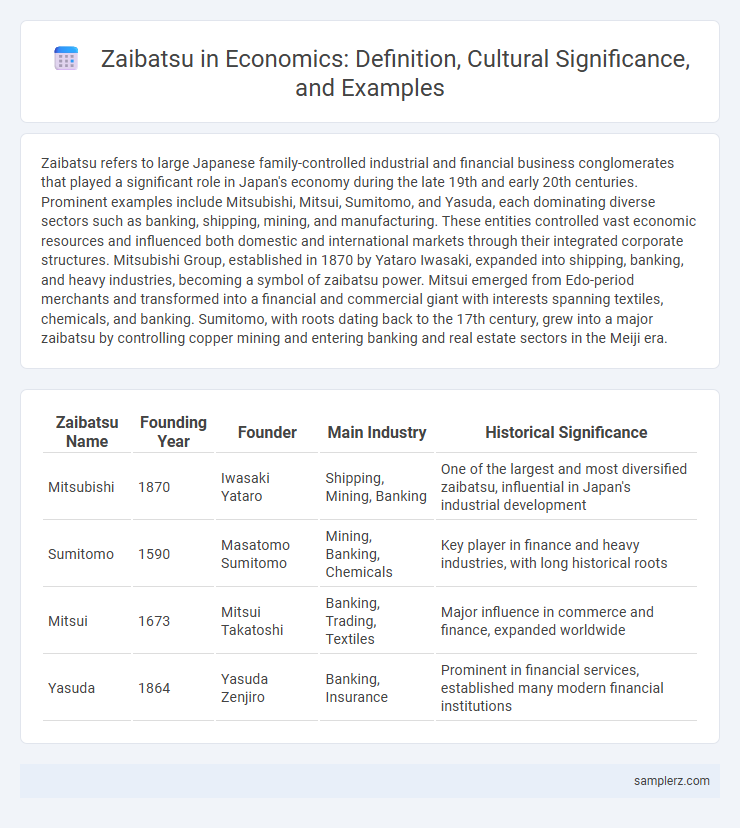Zaibatsu refers to large Japanese family-controlled industrial and financial business conglomerates that played a significant role in Japan's economy during the late 19th and early 20th centuries. Prominent examples include Mitsubishi, Mitsui, Sumitomo, and Yasuda, each dominating diverse sectors such as banking, shipping, mining, and manufacturing. These entities controlled vast economic resources and influenced both domestic and international markets through their integrated corporate structures. Mitsubishi Group, established in 1870 by Yataro Iwasaki, expanded into shipping, banking, and heavy industries, becoming a symbol of zaibatsu power. Mitsui emerged from Edo-period merchants and transformed into a financial and commercial giant with interests spanning textiles, chemicals, and banking. Sumitomo, with roots dating back to the 17th century, grew into a major zaibatsu by controlling copper mining and entering banking and real estate sectors in the Meiji era.
Table of Comparison
| Zaibatsu Name | Founding Year | Founder | Main Industry | Historical Significance |
|---|---|---|---|---|
| Mitsubishi | 1870 | Iwasaki Yataro | Shipping, Mining, Banking | One of the largest and most diversified zaibatsu, influential in Japan's industrial development |
| Sumitomo | 1590 | Masatomo Sumitomo | Mining, Banking, Chemicals | Key player in finance and heavy industries, with long historical roots |
| Mitsui | 1673 | Mitsui Takatoshi | Banking, Trading, Textiles | Major influence in commerce and finance, expanded worldwide |
| Yasuda | 1864 | Yasuda Zenjiro | Banking, Insurance | Prominent in financial services, established many modern financial institutions |
Historical Overview of Zaibatsu in Japan’s Economy
Zaibatsu were powerful family-controlled conglomerates that dominated Japan's economy from the Meiji era until the end of World War II, shaping industrial growth through extensive control over banking, manufacturing, and trade. Key zaibatsu such as Mitsubishi, Mitsui, Sumitomo, and Yasuda integrated vertically and horizontally, influencing economic policies and Japan's modernization. Their dissolution by the Allied Occupation marked a significant shift, leading to the emergence of keiretsu networks and a more diversified economic structure.
Key Characteristics Defining Zaibatsu Conglomerates
Zaibatsu conglomerates in the Japanese economy were characterized by centralized family ownership, vertical integration, and control over diverse industries such as banking, manufacturing, and trade. These powerful entities maintained significant influence through close ties with the government and financial institutions, enabling monopolistic practices and economic dominance during the pre-World War II period. Their hierarchical structure and interlocking shareholdings facilitated coordinated decision-making and resource allocation across multiple sectors.
Mitsui: The Oldest Zaibatsu Example
Mitsui, founded in the early 17th century, stands as the oldest and most influential zaibatsu, shaping Japan's economy through diverse businesses including banking, mining, and trading. Its powerful conglomerate structure helped modernize Japan's industrial landscape, with Mitsui's financial arm playing a crucial role in funding infrastructure and technological advancements. The legacy of Mitsui's zaibatsu persists today in the form of the Mitsui Group, a keiretsu that continues to impact global markets.
Mitsubishi: Pioneering Innovation in Industry
Mitsubishi, one of Japan's most influential zaibatsu, revolutionized various industries by pioneering advancements in shipbuilding, automotive manufacturing, and heavy machinery. Founded in the 19th century, Mitsubishi expanded its economic footprint through strategic diversification and innovation, shaping Japan's modernization. Its legacy in corporate structure and industrial technology continues to impact global markets and economic practices today.
Sumitomo: Wealth and Influence through Centuries
Sumitomo Group, one of Japan's most prominent zaibatsu, has shaped the economy through its diverse enterprises in mining, banking, and manufacturing since the 17th century. Renowned for its emphasis on ethical business practices rooted in Confucian values, Sumitomo expanded its influence during the Meiji Restoration and post-war industrialization. The group's enduring wealth and strategic diversification exemplify the economic power and cultural impact zaibatsu held in Japan's modernization.
Yasuda: Banking Dominance and Economic Power
Yasuda zaibatsu exemplified economic influence through its dominant banking operations, controlling Yasuda Bank as a central financial institution that fueled industrial growth in pre-war Japan. The conglomerate's extensive network enabled strategic investments across banking, insurance, and manufacturing sectors, reinforcing its economic power. This dominance positioned Yasuda as a critical player in shaping Japan's modern economic landscape.
Zaibatsu Role in Japan’s Industrialization
The zaibatsu, such as Mitsubishi and Sumitomo, played a crucial role in Japan's industrialization by centralizing economic power and fostering large-scale industrial enterprises. These family-controlled conglomerates integrated banking, manufacturing, and trading, enabling efficient capital allocation and technological advancement. Their influence accelerated Japan's transformation into a modern industrial economy in the late 19th and early 20th centuries.
Zaibatsu Influence on Global Trade and Expansion
Zaibatsu like Mitsubishi and Sumitomo played a crucial role in shaping Japan's global trade networks during the early 20th century by leveraging their extensive industrial and financial resources. These conglomerates facilitated international expansion through strategic investments in shipping, manufacturing, and banking, significantly boosting Japan's presence in Asia and beyond. Their integrated business model enabled efficient coordination across diverse sectors, accelerating economic growth and global market penetration.
Post-War Dissolution and Transformation of Zaibatsu
The post-war dissolution of zaibatsu marked a significant transformation in Japan's economic landscape, as Allied occupation forces implemented antitrust measures to break up these powerful family-controlled conglomerates. Major zaibatsu such as Mitsubishi, Mitsui, Sumitomo, and Yasuda were restructured into smaller, independent companies, fostering increased competition and diversification in the Japanese economy. This fragmentation laid the groundwork for the emergence of keiretsu, loose networks of interlinked businesses that preserved some zaibatsu characteristics while promoting corporate collaboration and modernization.
Legacy of Zaibatsu in Modern Japanese Corporations
The legacy of zaibatsu is evident in modern Japanese corporations such as Mitsubishi, Sumitomo, and Mitsui, which evolved from pre-war family-controlled conglomerates into diversified multinational corporations. These companies retained their hierarchical management styles and strong inter-company relationships, influencing Japan's keiretsu system that promotes cross-shareholding and long-term partnerships. Their historical dominance shaped business practices emphasizing corporate loyalty, stable employment, and integrated supply chains in today's economy.

example of zaibatsu in economy Infographic
 samplerz.com
samplerz.com